The History of the Arms and Great Seal of the Commonwealth of Massachusetts
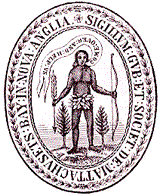
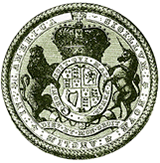
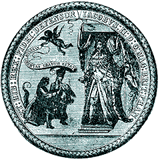
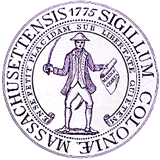
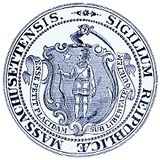
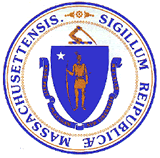
The History of the Arms and Great Seal of the Commonwealth of Massachusetts
Seals, such as those that appear on documents certified by the Secretary of the Commonwealth of Massachusetts, have a long history and were mentioned
even in the Bible. They were widely used many centuries ago because most
persons, even of high rank and wealth, did not read or write. Acceptance
of a document was signified by making an impression of one's coat of arms
into a blob of soft wax, usually with an engraved signet ring. There was
a general reluctance to affix seals to documents unless absolute certainty
of the contents could be confirmed. This eventually led to the idea that
documents of state and other important personal papers, such as deeds,
should contain a seal that bore witness to their authenticity.
In 1629, King Charles I granted a charter to the Massachusetts Bay Colony,
which included the authority to use a seal. It featured an Indian holding
an arrow pointed down in a gesture of peace, with the words "Come
over and help us," emphasizing the missionary and commercial intentions
of the original colonists. This seal was used until 1686, shortly after
the charter was annulled, and again from 1689-1692.
From 1686 to 1689 Governor Edmund Andros used a seal with two sides,
one side showing King James II with an Englishman and Indian kneeling
in front of him, the other side showing the lion and unicorn of the royal
coat of arms. When the Province of Massachusetts began in 1692, the royal
coat of arms of England, combined with a motto specific to the reigning
monarch, became the official seal. Royal governors affixed their personal
seals to commissions issued to officers in the military service.
When the conflict between the province and England began in 1775, General
Thomas Gage, the royal governor, had custody of the province seal. As
his authority was no longer recognized by the province it became necessary
to establish a new public seal. The General Court passed an order on July
28, 1775, appointing a committee to consider "what is necessary to
be done relative to a Colony Seal." The design adopted was that of
an English-American man holding the Magna Carta. The seal was engraved
by Paul Revere, whose original signed bill for the work is located in
the Massachusetts Archives. A motto in Latin was also chosen - "Ense
petit placidam sub libertate quietem" - which remains the motto of
the Commonwealth today. Freely translated this means, "By the sword
we seek peace, but peace only under liberty." It was written about
1659 and is attributed to the famous English patriot, Algernon Sydney.
Soon after its first meeting under the Massachusetts Constitution, the
state legislature appointed a committee "to consider & determine
upon a Seal for this Commonwealth." A month later, on December 13,
1780, the Council and Governor John Hancock accepted Nathan Cushing's
design for a new seal. Paul Revere was once again commissioned to engrave
the seal, which returned to its original design of a native American Indian.
Revere presented his bill on December 23, 1780 - the signed original is
located at the Massachusetts Archives. The Council provided only a casual
description of how the seal should look, so subsequent engravers varied
the appearance of the seal.
It was not until June 4, 1885, that the legislature prescribed the seal
in its present form. According to St.1885, c. 288:
The great seal of the Commonwealth shall be circular in form, and
shall bear upon its face a representation of the arms of the Commonwealth,
with an inscription round about such representation, consisting of the
words "Sigillum Reipublicae Massachusettensis"; but the colors
of such arms shall not be an essential part of said seal, and an impression
from a engraved seal according to said design, on any commission, paper
or document of any kind, shall be valid to all intents and purposes whether
such colors, or the representation of such colors by the customary heraldic
lines or marks, be employed or not.
The arms, which form the central part of the Great Seal
. . . shall consist of a shield, whereof the field or surface is blue,
and thereon an Indian dressed in his shirt and moccasins, holding in his
right hand a bow, and in his left hand an arrow, point downward, all of
gold; and in the upper corner above his right arm, a silver star with
five points. The crest shall be a wreath of blue and gold, whereon is
a right arm, bent at the elbow, and clothed and ruffled, the hand grasping
a broadsword, all of gold. The motto shall be "Ense petit placidam
sub libertate quietem."
Starting in 1894 there was an attempt to provide a more accurate representation
of the appearance of the Indian on the Great Seal. Secretary of the Commonwealth
William M. Olin consulted various ethnologists, and the Indian was redesigned
within the restrictions of the 1780 and 1885 laws. In 1898, Edmund H.
Garrett's design was made the official representation of the coat of arms
for the state, according to St. 1898, c. 519:
The coat-of-arms as drawn and emblazoned under the direction of the
present secretary of the Commonwealth, and now deposited in the office
of said secretary, is hereby adopted and declared to be the official representation
of the coat-of-arms of the Commonwealth of Massachusetts, and all designs
of said coat-of-arms for official use shall conform strictly to said representation.
The Great Seal is in the custody of the Secretary of the Commonwealth, who is required by the Constitution to affix an impression of it to all commissions (official appointments) issued in the name of the Commonwealth. The use of the coat of arms and the Great Seal of the Commonwealth for advertising or commercial purposes is prohibited by law. In addition to commissions, all records certified by the Secretary must bear the Great Seal. Permission to use the coat of arms and the Great Seal must be obtained from the Secretary of the Commonwealth. Contact the Public Records Division at 617-727-2832 with any questions regarding appropriate uses.